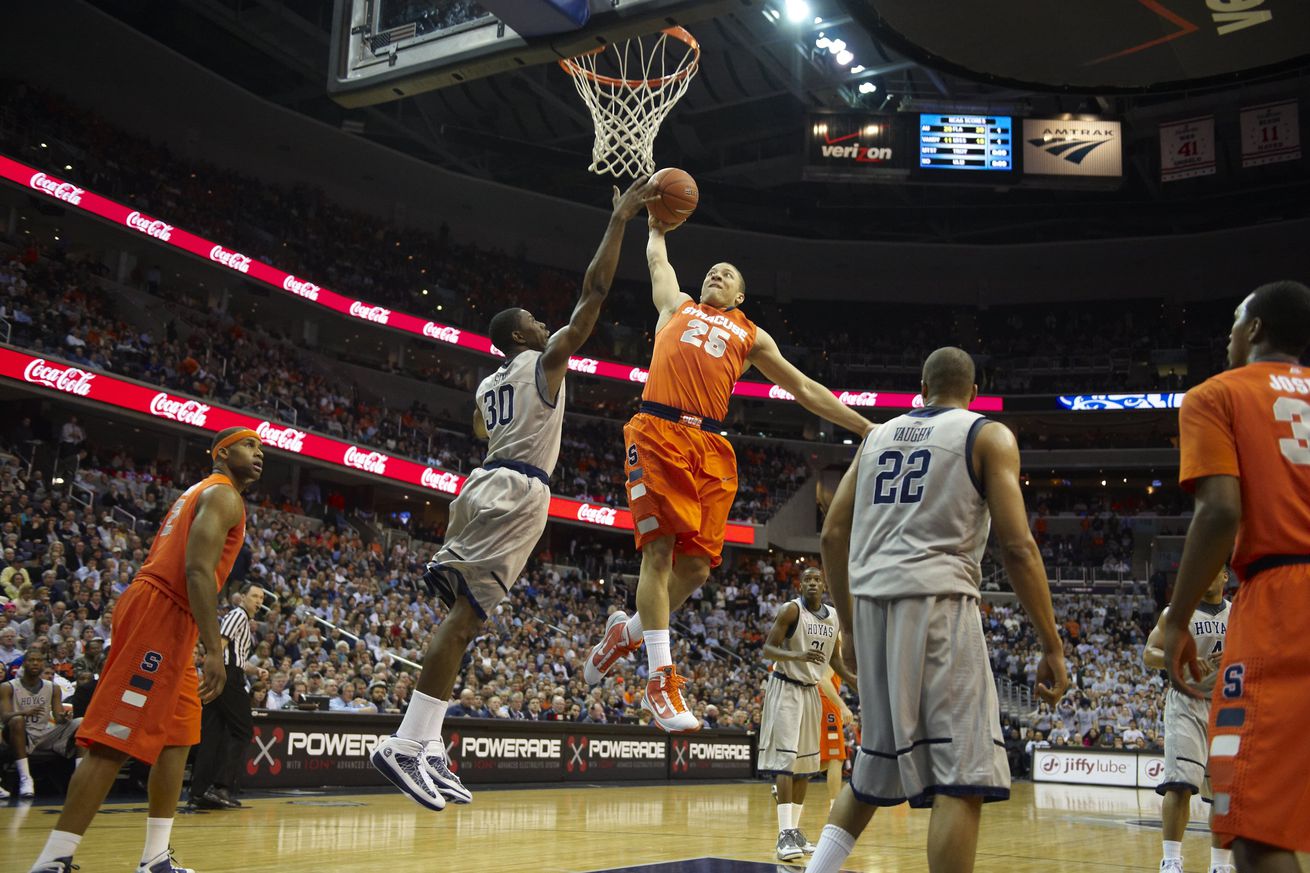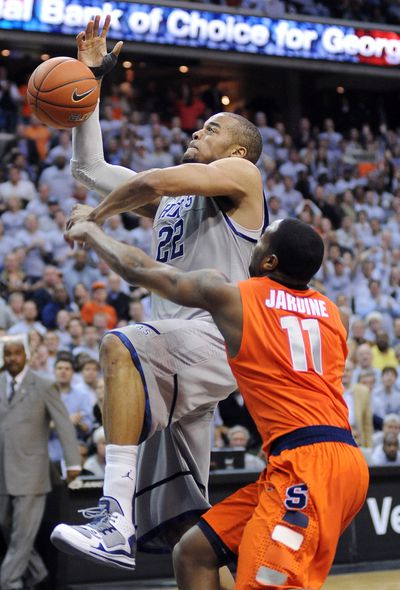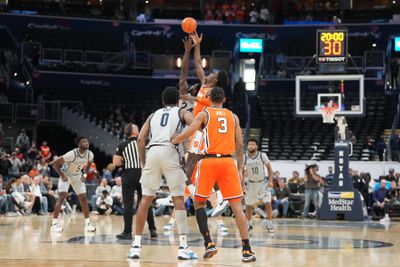
Can the seeds planted almost a century ago for one of college basketball’s most historic rivalries still keep growing from here?
In anticipation for a historic showdown between the Syracuse Orange and Georgetown Hoyas, there’s a clear case to be made no one who is more eager to get to Saturday than coach Ed Cooley.
“I can’t tell you how much I’m looking forward to this goddamn game next year,” Cooley said after Syracuse defeated Georgetown 80-68 last season in Washington.
Just over a year later, Cooley and the Hoyas are now making the trip up to Syracuse to face the Orange for the 100th time, a major milestone for a rivalry boasting plenty of incredible moments, cultural significance, star-studded players and deep-rooted disgust for the other side.
Heading into the landmark game, Syracuse coach Adrian Autry knows he needs to have his team fully prepared. Anytime the Orange are playing Georgetown, there is more than the final score at stake.
“They all understand. This is a great rivalry. Most of us in here, we know what the rivalry is, but these guys, some of these guys they don’t,” Autry said Tuesday after Syracuse beat UAlbany. “And I’m sure coach Cooley is doing the same with his guys.”
But outside the question of who actually wins, there’s a few more that will certainly make its way into the spotlight… at least going forward after this 100th game.
Where does the Syracuse-Georgetown rivalry go from here? Can it ever return to what it used to be?
Purely on the years alone, the Syracuse-Georgetown history is rich and there’s plenty of it. The first seeds were planted early.
Both teams first faced off in February 1930 back when Syracuse competed at the Manley Field House (writer’s note: the Orange won 40-18… lol). The Great Depression had just started several months earlier. Looney Tunes became a thing that same year. Prohibition was still around. Jim Boeheim was still 30 years away from just playing for the program.
Syracuse dominated early, winning 11 of the first 15 ever games. Then came Georgetown’s turn. The Hoyas won the next five. In 1980, the then-No. 2 Syracuse — right at the height of the “Louie (Orr) and (Roosevelt) Bouie Show” — came up short in a 52-50 slugfest at home. Georgetown head coach John Thompson sent Manley to its grave.
Literally.
“Manley Field House is officially closed. May it rest in peace,” read the front page of the sports section in The Washington Post.
From that game on, the seeds of the rivalry weren’t just sprouting. They grew and never stopped, forming this incredible tree in college basketball that was the Syracuse-Georgetown rivalry. From 1981 to the end of the 20th century, there’s no question this was as bitter and close as the series ever got historically.
A total of 46 games, 23 wins for each team. Four clashes in the Big East championship game. Across all those matchups, the winning team averaged a margin of victory of roughly 7-8 points when you do the math. Georgetown dominated the 1980s. Syracuse commanded the 1990s.
Amid those 20 years, a jackpot of memories. Pearl Washington’s game-winning jumper and free throw in 1985. Patrick Ewing dominating the Orange in 1984, all in front of a packed Madison Square Garden crowd. Thompson getting three technical fouls and being ejected in 1990. Lawrence Moten outdueling Alonzo Mourning in 1992. Charles Smith hitting whatever the hell this shot was in 1988:
1988 Big East Hoops @GeorgetownHoops at Syracuse Charles Smith game winner. pic.twitter.com/PgdqxIbXNR
— Big East Rewind & Hoops 24/7 (@bigeastrewind) May 7, 2020
The tree kept growing even larger, the rivalry extending well into the 21st century. That’s the chapter of the story a decent portion of the fanbase (myself included) grew up with. The games were too iconic and so were the players. There’s a laundry list of them: Jonny Flynn, Roy Hibbert, Wes Johnson, Greg Monroe, Gerry McNamara, Jeff Green, Jerami Grant, Otto Porter. There’s room for so much more from this century and the one before.

Chuck Myers/Tribune News Service via Getty Images
The turning point came in 2012-13 when Syracuse jumped ship to the ACC. Of course the rivalry would be impacted. Playing Georgetown two to three times in the Big East Conference in a given season was different than playing as non-conference opponents in the fall.
The final part of this chapter of the rivalry ended the only way it could: No. 19 Syracuse beating No. 5 Georgetown in the 2013 Big East Tournament semifinals (writer’s note: fortunately, it’s a game which resides in full over on YouTube). The Orange escaped 58-55 in overtime, with Jabril Trawick’s half-court attempt in the final seconds hitting the backboard but hitting just to the left of the basket.
That’s not to say the matchup hasn’t been competitive since then. Since 2015-16 (when both teams resumed playing against each other at least once), Syracuse has played G-Town nine times, the final results going 5-4 in favor of the Orange — two games total where the victor won by double-figures).
Just like the good ‘ol days, the tree still managed to grow even as the conditions changed.

Photo by Mitchell Layton/Getty Images
It goes beyond the rivalry’s circumstances changing. So too have the programs. Going back a full decade, Syracuse has made the NCAA Tournament four times (including a Sweet 16 and a Final Four), but also has missed the last three tournaments and is clearly still a program building a new foundation post-Boeheim. G-Town found itself even in a worse spot: five years below-.500, one tournament bid and a one disastrous six-year tenure for the program under coach Ewing.
For both teams, the potential is there. Georgetown (7-2) already has matched its win total from two years ago and is closing in on the number of wins it had in Cooley’s first season (nine). In Syracuse’s case, substantial improvements in recruiting are offering its fanbase some optimism to at least feel good about.
With the 100th Syracuse-Georgetown game closing in, everything mentioned does still matter even if the teams, amount of success and context has. The tree hasn’t moved, and neither have the branches — all those memorable players, the energy, the loud fans in both cities, the legacies, the elite moments, the significance.
Both teams agreed back in 2022 to extend the series at the time for the next two years. To my knowledge, there is nothing public confirming what will happen to it moving forward, but during their last matchup, both Autry and Cooley fully endorsed wanting to keep the series going.
“As long as I’m the head coach, I want to play Syracuse every year,” Cooley said in December 2023.
“This is not just, you know, us, this is about people that have played before us… we want to continue to series, we want this series alive, and it’s a good series,” Autry said in December 2023. “I think as it continues to build and I continue to build, this series will get the pop and the respect that it deserves.”
In the world of college basketball and athletics, things will always change. Many long for the day where both programs can eventually get back to what they used to be and compete at a high level, whether it be a highly-anticipated matchup once a year like it is now, in the tournament or maybe in some ridiculous mega-hypothetical Northeast Conference that could be created down the road (at this point, anything is on the table in the world of college athletics realignment).
Regardless of what comes next, the Syracuse-Georgetown rivalry remains one of college basketball’s oldest, most notable in history. The 100th game will certainly add another branch to the tree whose seeds initially created the foundation almost a century ago.
Going forward, the hope for both fanbases is that the tree doesn’t get forgotten or wither away.